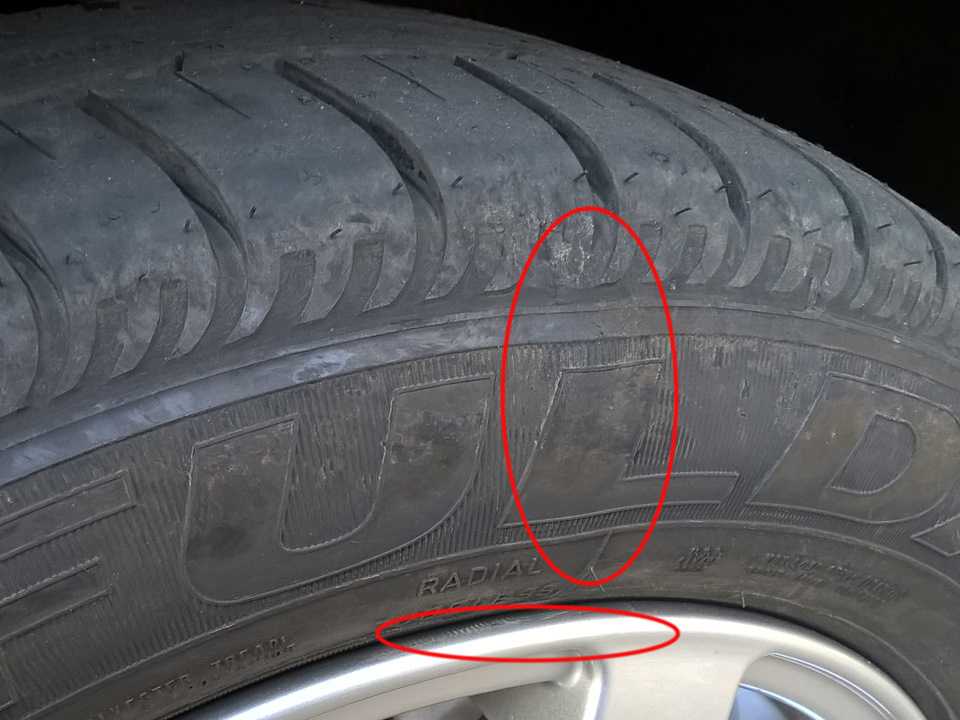Tires can become damaged for a variety of reasons, and it can happen without the driver being immediately aware there's a problem. The most common types of damage are punctures, cuts, impacts, cracks, bulges and irregular wear. In this section, we'll explain the signs and symptoms to help you diagnose the issue, plus some useful tips on how to prevent them.
There are several types of irregular wear, the most typical variations being heel and toe wear, one-sided wear, and center wear. Here we explain how and why they occur.
a. Heel and toe wear
Heel and toe wear is a pattern caused by normal usage and suspension settings. It's the outwardly visible (and audible) manifestation of various distortional forces at work on the tread. To explain further, let's dive a little deeper into the design of the tread.
Tread grooves and sipes are essential in ensuring safety on wet and flooded roads. Particularly with low-profile tires, a higher percentage of tread void is necessary to take up the water and to improve protection against aquaplaning. Cross-grooves for water drainage take the form of freestanding blocks in the shoulder area. These shoulder blocks can wear into a heel and toe pattern as a result of rolling mechanisms under certain operating conditions.
These operating conditions include:
While the tire is rolling along the road, the freestanding blocks deform as they approach the contact patch of the tire, and they're compressed as they touch the tarmac. After they lose road contact, however, the blocks will snap back into their original shape, rubbing the surface as they do so. The result is a wear pattern on the block run-out edge, and it's more likely to appear on non-driven wheel positions.
A minor amount of heel and toe pattern wear is reasonable and has no discernible effects on driving comfort. But if the wear is more extensive, more specific issues may be at fault. These can range from improper inflation, excessive toe-in, and low-wear applications.
b. Center wear
You can find this wear pattern on the driven wheels of highly motorized cars. During energetic acceleration, in stop-start urban traffic, or when accelerating away from traffic lights, these high torque levels can quickly increase wear of the tread center. Even today’s mid-range vehicles have modern engines which can generate high levels of torque and are capable of producing high degrees of slip.
c. One-sided wear
The single biggest reason for one-sided wear is because of axle geometry. Deviations can develop over time and are the result of, for example, aggressively mounting a curb.
Lowering the height of a vehicle in conjunction with low-profile tires can also affect wheel alignment. During driving, modified suspension arms tend to deviate the alignment of the wheels from the specified position. The problem can catch drivers unaware, because wheel alignment values can still be found to be within tolerance limits when measured in a static position on an axle measurement bench. But the manufacturer’s alignment data applies to vehicles as delivered and may not necessarily apply to customized cars. Thus, the result may be an increase in non-uniform treadwear.
During driving, modified suspension arms tend to deviate the alignment of the wheels from the specified position. The problem can catch drivers unaware, because wheel alignment values can still be found to be within tolerance limits when measured in a static position on an axle measurement bench. But the manufacturer’s alignment data applies to vehicles as delivered and may not necessarily apply to customized cars. Thus, the result may be an increase in non-uniform treadwear.
If a vehicle’s wheels are misaligned, a qualified specialist can correct the deviation by re-aligning the wheels.
An impact break is damage inflicted on the carcass (the casing of the tire) after the tire comes into contact with certain obstacles. A pronounced bulge on the sidewall of the tire indicates destroyed cords inside the carcass.
Damage of this kind is usually caused by driving over objects – like curbs or speed bumps – at excessive speed or the wrong angle.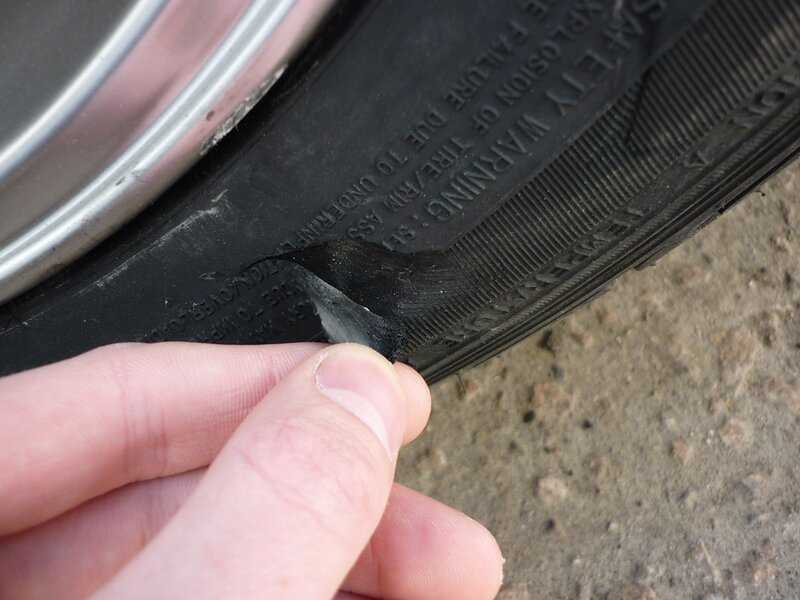 Overstressing the carcass causes individual cords to break. The exact extent of the damage will depend on the speed and angle of impact, and the size of the obstacle. Careful motorists are usually able to avoid this type of damage, unless an obstacle suddenly appears in front of a vehicle and they can't steer around it.
Overstressing the carcass causes individual cords to break. The exact extent of the damage will depend on the speed and angle of impact, and the size of the obstacle. Careful motorists are usually able to avoid this type of damage, unless an obstacle suddenly appears in front of a vehicle and they can't steer around it.
Ignoring such damage increases the risk of tire failure at some point in the future, either delamination of the tread and plies or disintegration of the tire sidewall.
An impact break is sometimes confused with a sidewall indentation, but they are not the same thing. As we explain below, dimples or indentations in the sidewall are not a cause for alarm.
A tire sidewall is not always perfectly even; sometimes there will be dimples and indentations and may require a more detailed inspection to determine the causes. The essential thing to know is that indentations are harmless and aren't detrimental either to driving or safety characteristics.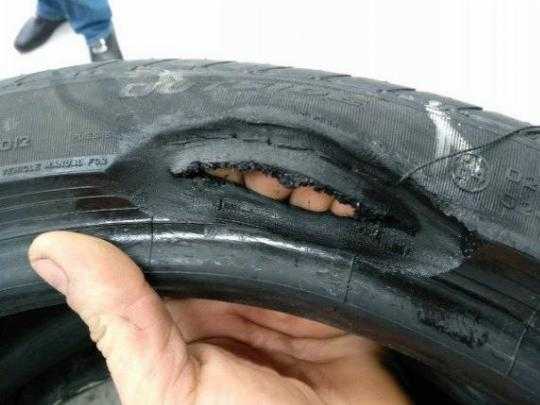 The dimples are superficial.
The dimples are superficial.
Indentations in the tire are best illustrated if you were to imagine tying a string around an inflated balloon and then gently pulling the string tighter. If the balloon is the tire, the string is the embedded carcass cords which are concealed by the rubber. These cords provide the tire with its strength and stability, and transfer steering and braking forces while driving.
During manufacture of a tire – or rather when constructing the carcass, to which the steel belt and the tread are attached – there are often one or two overlaps in the carcass. It's this overlap which is sometimes visible as an indentation after the tire is fitted and inflated.
But if you're in any doubt, have the sidewall indentations checked by a qualified tire specialist.
Cuts are the result of external influences like bad road conditions, protruding bodywork parts, or sharp, foreign objects such as stones or glass. If you discover damage in the form of a cut on the tire surface, you should visit your local tire dealer and have your tires immediately checked by an expert.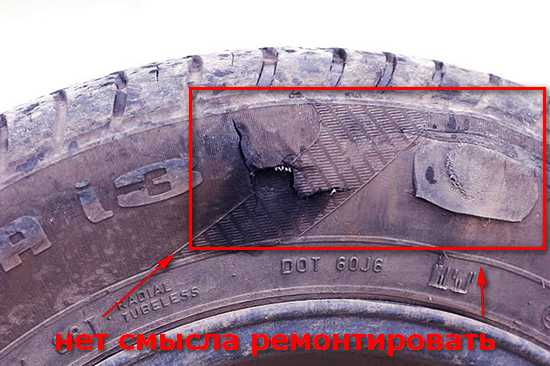
Punctures are the consequence of sharp objects on the road – for example, nails, screws, or broken glass – which pierce through the surface of the tire. If the puncture is deep enough, the tire could begin to lose air pressure. If you find that one or more of your tires are continuously losing pressure, or if you discover a nail or screw embedded in the tread, then visit your local tire specialist as soon as possible to have them repaired.
Change the position of the tires on the car at regular intervals (unless otherwise recommended by the vehicle manufacturer) to promote even tire wear. The position of the tires should be rotated, for example, when making the seasonal transition from summer to winter tires.
By rotating the wheels from the powered to the non-powered axle on a regular basis, drivers can expect to have a uniform pattern of wear on their tires. But as always, please observe the recommendations provided by the vehicle manufacturer.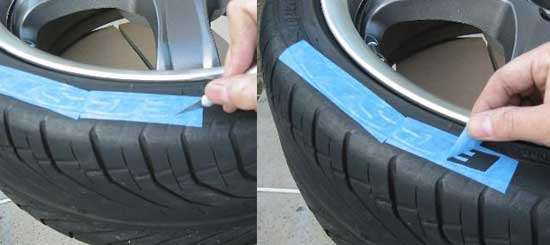
If you find yourself in a situation where you have to drive over an obstacle in the road, approach it slowly and as close to the perpendicular as possible. Afterward, check your tires for exterior damage such as cuts, cracks or bulges. Also, avoid driving aggressively on unpaved roads.
Dealer Locator
Tire damage can be terrifying, as is the bill to get it fixed. The easiest way to deal with it is just to avoid it altogether. Of course, some have better luck with this than others, and sometimes stuff just happens, but we’ll armor you with some information and tips on how to prevent tire damage as best as you can. To kick this off, we’ll explain four of the most common types of damage: irregular wear, impact damage, cuts, and punctures.
Irregular wear:
This is when one part of the tire wears more quickly than others. This can be one sided wear, center wear, or braking flat tops. Another common example is called head to toe wear; this is when there’s higher wear on the block run-out edge.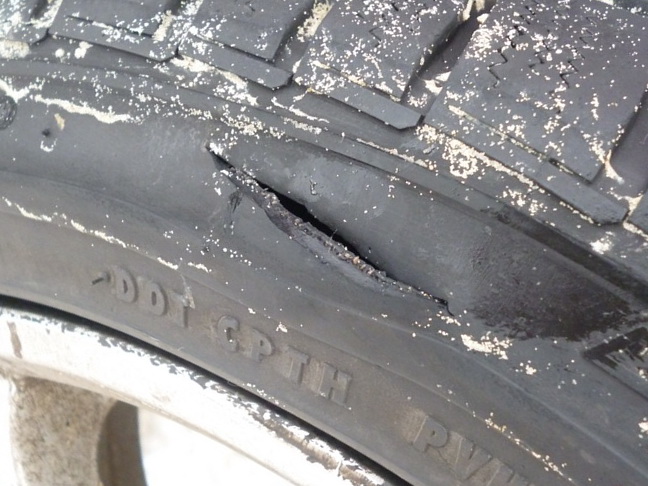 Not sure what that means? Don’t worry, you’re not alone. This happens when when tire air pressure is incorrect. To avoid irregular wear on your Accelera beauties, make sure your air pressure is accurate and you’re rotating your tires regularly.
Not sure what that means? Don’t worry, you’re not alone. This happens when when tire air pressure is incorrect. To avoid irregular wear on your Accelera beauties, make sure your air pressure is accurate and you’re rotating your tires regularly.
Impact damage:
This involves damage to the carcass – aka the casing of the tire. It most often includes breaks or bulges. If you notice an externally visible bulge on the sidewall, that means that cords have been destroyed. While some impact damage is hard to avoid, curbs and similar obstacles, such as potholes, should only be driven over at an wide angle and at a relatively slow speed.
Cuts:
Cuts are pretty self-explanatory and typically pretty obvious to spot. They’re usually a result of sharp objects on the road. Unfortunately, once they happen, there’s really no way around it. Go see your local tire dealer immediately.
Punctures:
These are also usually a result of sharp objects on the road, but could be a bit harder to spot than cuts. They can vary in size, which then varies the severity of their effects. The most common consequence would be losing tire pressure. You’ll most likely need to visit your local tire dealer for these as well.
They can vary in size, which then varies the severity of their effects. The most common consequence would be losing tire pressure. You’ll most likely need to visit your local tire dealer for these as well.
Extra tips:
When trying to repair any of these damages, it’s important to remember that external “plugs” are not recommended – repairs should be made from the inside. In other words, just hire a professional. And make sure they do it well.
In terms of trying to prevent tire damage, there a few things it’s best to avoid altogether. Avoid potholes, curbs, and debris in the road – however, don’t recklessly swerve into another lane to do so. Check to see if it’s a safe option first and if it’s not, continue at a safe or lower speed to minimize the impact. Also, avoid overloading your vehicle. Overloading can severely damage your tires or even cause a blowout, so check your owner’s manual to make sure you’re not overloading your tires. Finally, keep your tires properly inflated. This will lengthen the life of your tires, improve your gas mileage, and give you better handling, more dependable traction, and a better ride.
This will lengthen the life of your tires, improve your gas mileage, and give you better handling, more dependable traction, and a better ride.
LADA
UAZ
KIA
Hyundai
Renault
Toyota
Volkswagen
Skoda
Nissan
BM -Benz
Mitsubishi
Mazda
Ford
All brands
Most often, we ourselves are to blame for the fact that tires become unusable. But this can be avoided.
Related materials
You have never seen such tires: even the police were surprised
In the process of using a tire, a variety of damages can occur, most of which are the fault of the driver. As a result, rubber is wasted, and since the law prohibits the use of different tire models on the same axle, you have to spend money on replacing the second tire.
The most common damage is puncture . This is the most harmless type of damage, but only if you notice it in time and repair it right away. It is absolutely impossible to drive on a flat tire, even a couple of meters! The damage caused by running on a flat tire or with low pressure is catastrophic. This causes the sidewalls to deform more than they should, which causes the tire to overheat, delaminate, and the carcass becomes unusable due to broken cords. As a result, the tire will have to be thrown away. In addition, the edge of the rim can also be damaged. nine0003
This is the most harmless type of damage, but only if you notice it in time and repair it right away. It is absolutely impossible to drive on a flat tire, even a couple of meters! The damage caused by running on a flat tire or with low pressure is catastrophic. This causes the sidewalls to deform more than they should, which causes the tire to overheat, delaminate, and the carcass becomes unusable due to broken cords. As a result, the tire will have to be thrown away. In addition, the edge of the rim can also be damaged. nine0003
Punctures are of two types: with and without cord damage. To determine this, it is necessary to remove what pierced it. If the edges of the puncture tightly converge, then the cord is not damaged and it will be possible to repair the tire without removing it from the disk. Otherwise, if the edges do not converge, you will have to disassemble the wheel and make repairs with strengthening the frame from the inside. Alternatively, in the field and in the absence of a spare wheel, such a puncture can be repaired without removing the tire from the rim, after which you can carefully drive to a tire fitting or garage and make a full repair. nine0003
nine0003
Related materials
Is it possible to pump up a wheel without a compressor - the experiment "Behind the wheel"
When repairing, the puncture site should be cleaned and marked. Further, it all depends on what kind of repair kit you have - as a rule, instructions are attached to them. There are sealants that are poured into the tire through the nipple, after which the wheel turns with the puncture down and the substance seals the hole. Repair using a tourniquet or insert is somewhat more complicated, but also more durable: the edges of the hole are polished with a special tool, after which the tourniquet treated with a special compound must be inserted into the tire through a puncture with a special awl, pulled out (not completely) out and cut flush with the surface. nine0003
In case of damage to the cord due to a puncture, the tire must be removed from the rim in order to install a reinforced patch with an additional cord on its inner surface.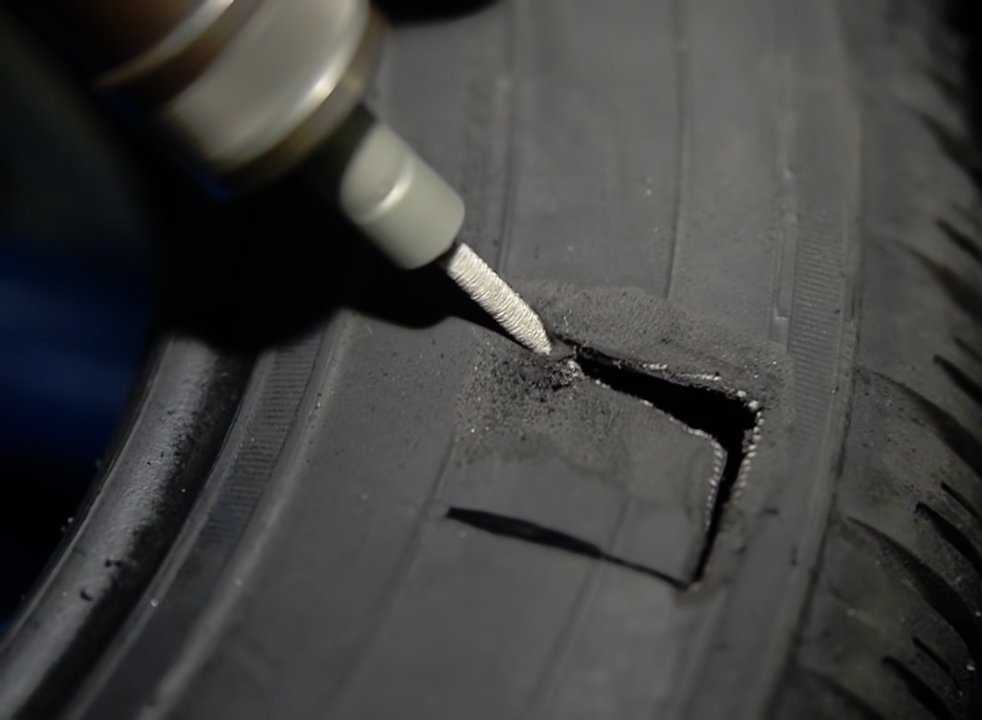 One of the sides of such patches has an adhesive layer that promotes cold vulcanization. After such a repair, wheel balancing will be required. To seal punctures from the inside, patches in the form of a mushroom are also used, with a leg that goes into the puncture. Such patches are also covered with a special adhesive for cold vulcanization. nine0003
One of the sides of such patches has an adhesive layer that promotes cold vulcanization. After such a repair, wheel balancing will be required. To seal punctures from the inside, patches in the form of a mushroom are also used, with a leg that goes into the puncture. Such patches are also covered with a special adhesive for cold vulcanization. nine0003
Cuts or holes , unlike punctures, are not repairable, as they violate the integrity of the frame, which can no longer be strengthened. In addition, breakdowns are always sudden and occur on the go: the tire abruptly loses pressure and before the car comes to a complete stop it has time to make several revolutions “on the rims”, which breaks the cord and destroys the layers. It is not recommended to use such a weakened tire, even if it was possible to repair and strengthen the place of the rupture or cut, in the future.
Related materials
8 tire storage rules - do you follow them all?
Incorrect storage of tires can cause cracks . The danger of such damage is that moisture enters the cord through cracks, which renders the frame unusable. In addition, air can escape through cracks. Unfortunately, cracks are not repairable, and tires with them will not last long: sooner or later they will deform, become covered with swellings due to rusted and torn cord or because of driving with pressure below the recommended one. nine0003
The danger of such damage is that moisture enters the cord through cracks, which renders the frame unusable. In addition, air can escape through cracks. Unfortunately, cracks are not repairable, and tires with them will not last long: sooner or later they will deform, become covered with swellings due to rusted and torn cord or because of driving with pressure below the recommended one. nine0003
Blisters or bulges can appear on a tire for a variety of reasons - it always happens due to a broken cord or delamination in the carcass. In the first case, an obstacle was hit and the impact broke the cord or the cord was cut through with a sharp object. In the second case, there is no damage on or near the hernia, which means that it appeared either due to a factory defect, or due to frequent driving with pressure below the recommended one. The danger of hernias is that they can explode at any moment and provoke a skid, which will lead to an accident. If there is nothing to replace a tire with a hernia, then it is better to rearrange it to the rear axle and drive very carefully.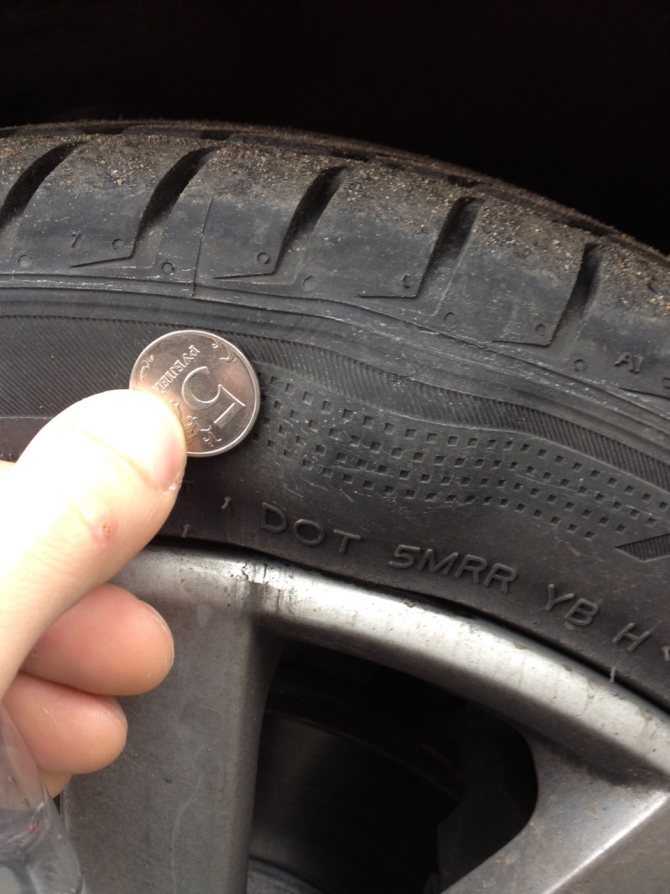 Like cracks, a hernia cannot be repaired. Sometimes small blisters resulting from impacts or cuts are reinforced with reinforced patches, but there is no guarantee that the tire will not explode. Therefore, tires with hernias are recommended to be replaced immediately. nine0003
Like cracks, a hernia cannot be repaired. Sometimes small blisters resulting from impacts or cuts are reinforced with reinforced patches, but there is no guarantee that the tire will not explode. Therefore, tires with hernias are recommended to be replaced immediately. nine0003
Related materials
Tire blackening - 6 ways to polish. Inexpensive!
Tire sidewalls can be damaged by rubbing against curbs or the asphalt edge when pulling over. If you are prone to such a driving style, then it is recommended to inspect the inner and outer sidewalls from time to time and, if abrasion is found, swap the wheels in order to prevent the cord from being exposed - the rubber thickness on the sidewalls is small (1.5–3 mm), and it can be rubbed to the frame very quickly. nine0003
Often the cause of tire damage can be poor-quality tire fitting , during which the bead ring was damaged. In this case, the tire loses its geometry and “sits” crookedly on the disk - it writes out “eights” during rotation, and lateral vibration appears during the ride. It is impossible to repair such a tire - you need to replace it with a serviceable one as soon as possible before it damages the suspension: rods, hubs and bearings.
It is impossible to repair such a tire - you need to replace it with a serviceable one as soon as possible before it damages the suspension: rods, hubs and bearings.
You can find out whether you are using tires correctly and what invisible damage they have received by the characteristic wear of the tread, the varieties of which are collected in the table for convenience:
Double side shoulder wear
Driving with lower than recommended tire pressure.
Inflate the tires to the pressure recommended by the automaker (a plate with recommendations is attached in the driver's door opening) and find the cause of the fall: puncture, cracks, hernia, nipple, rust on the disc rim in the place where the tire fits, etc.
Center wear
Tire pressure too high.
Reduce the pressure to the recommended (indicated on the tablet in the driver's doorway)
In the form of rings and furrows
can be found on trailers or rear wheels of pickups and vans due to vibrations and vibrations and vibrations due to vibrations and vibrations bouncing at high speeds.
Changing wheels on a loaded axle to equalize wear, driving with a heavier load. nine0003
Chipped wear with cuts
Frequent wheel spin on rocky surfaces.
Move the wheels to a non-driving axle, use the gas pedal more carefully when starting to move.
Photo: Petr Urbanek / Unsplash
Our new video
Sollers Argo and Atlant from Yelabuga: the Chinese couldn't do without
Test of Haval Dargo and Mitsubishi Outlander (video)
The story stopped on it: test of the last Volga
Like this post? Subscribe and you will always be in the know!
Driving in Zen
News smi2.ru
| 1. | Puncture | (P1) |
| 2. | Non-through single damage to the OBD | (P2) |
| 3. | Wear associated with suspension geometry problems | (P3) |
| 4. | Abrasion due to brake lock | (P4) |
| 5. | Sidewall Puncture | (B1) |
| 6. | Sidewall blind puncture | (B2) |
| 7. | Bead damage during assembly/dismantling | (K1) |
| 8. | Impact wrinkling the carcass without tearing the sidewall | (B3) |
| 9. | Inclined crease or carcass break on sidewall | (B4) |
| 10. | Tire sidewall pinching impact | (B5) |
| 11. | Shedding of the sealing layer | (G1) | nine0107
| 12. | Broken carcass or complete failure of a tire due to rolling without pressure | (G2) |
| 13. | Non-Michelin treadmill repair that collapsed during use | (P1) |
| 14. | Non-Michelin sidewall repair that collapsed during use nine0094 | (P2) |
(damage code P1)
Test damage to the opening (not to be confused with P7)
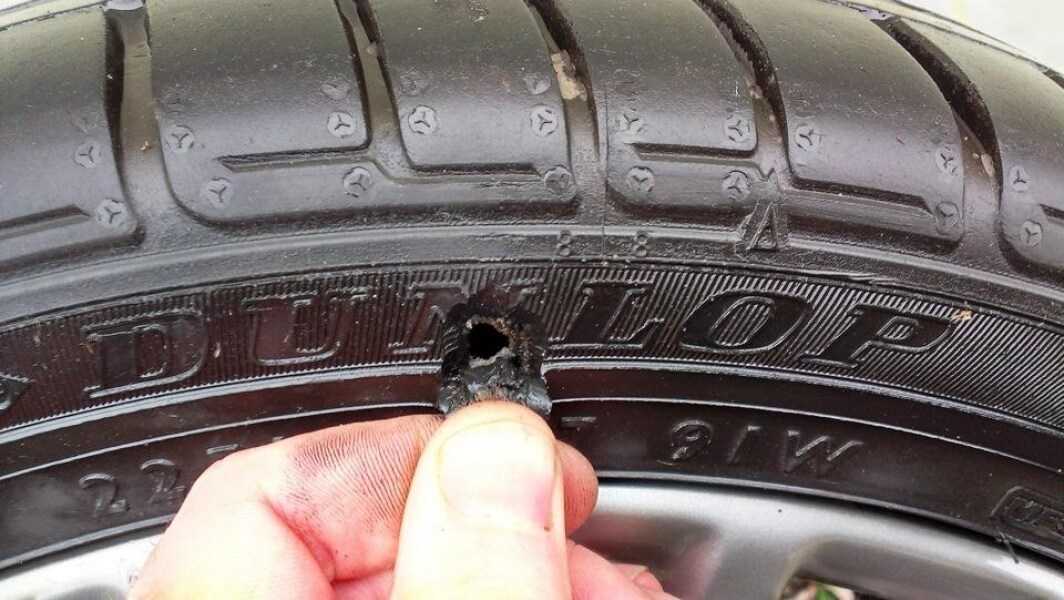 )
) (damage code P2)
Local non-penetrating single damage.
The damage may affect the breaker layers and carcass, but the sealing layer is not damaged.
Cap on extraneous objects (stones, bolts, nails, reinforcement, etc.)
(damage code P3)
This type of wear is the result of a violation of the geometry of the vehicle's suspension. It manifests itself in the form of "burrs" along the entire length of the ribs of the treadmill (it is detected when holding the palm across the treadmill). nine0003
Irregular vehicle suspension geometry. Vehicle axle misalignment.
Vehicle axle misalignment.
(Damage code P4)
This type of wear affects not only the rubber layer of the tread, but can also cause damage to the belt layers. nine0003
Locking (jamming) of the wheel due to problems with the wheel brakes.
(damage code B1)
Sidewall puncture. The carcass cord threads are not cut.
Collision with foreign objects (bolts, nails, rebar, etc.)0419
(Damage code B2)
Local non-penetrating damage in the form of cuts, scratches, tears, etc.
Cap on extraneous objects (stones, bolts, nails, fittings, etc.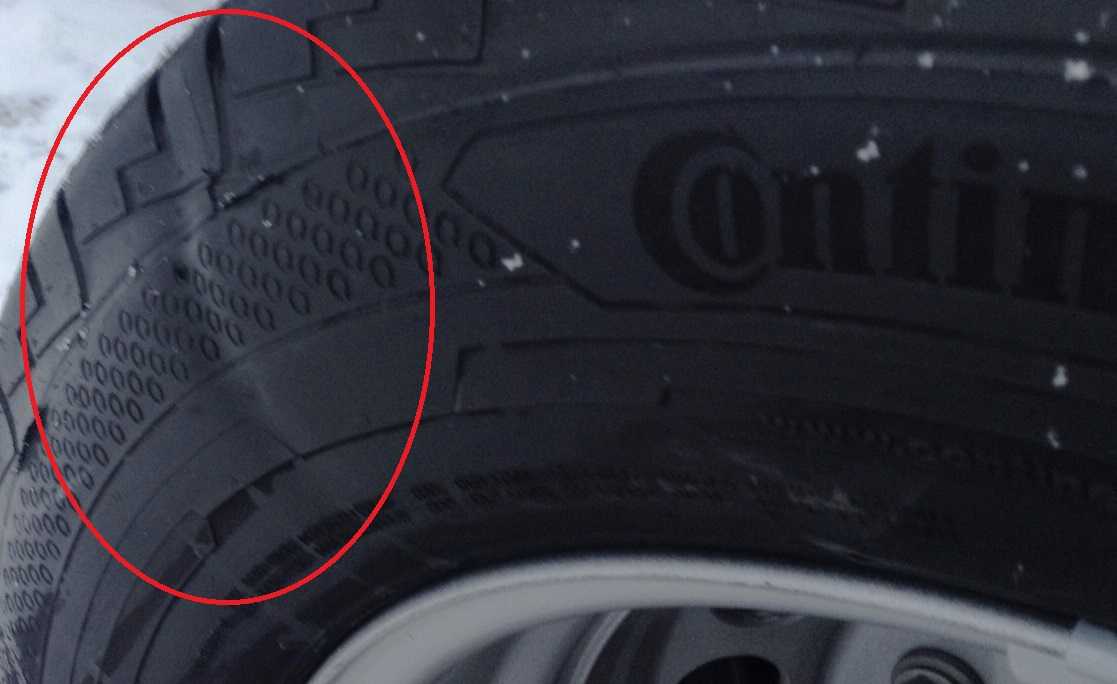 )
)
(damage code K1)
As a rule, it is a local damage to the bead cover rubber. It can be located both outside the tire and inside. nine0003
Violations of the rules for assembly and dismantling.
(damage code B3)
Local fold, often with scratches or scuffs of
BOVING BOOVING FOREMEN object (stone, pavement, etc.)
(Damage code B4)
Inclined carcass folds on the sidewall at the same distance from each other.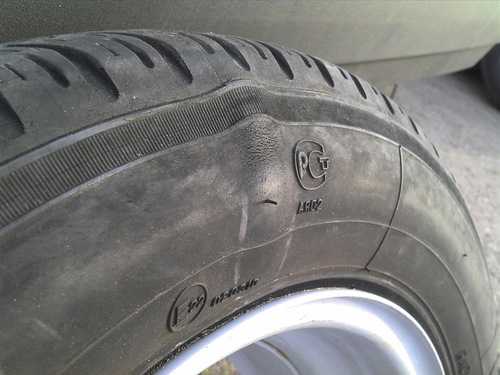 Frame breaks are possible.
Frame breaks are possible.
Loss of tire pressure.
(Damage code B5) Impact marks and scratches may remain at the site of damage. nine0003 This damage can be expressed in the form of deformation, folds, rupture or breakage of the sidewall reinforcement (rubber). Parallel to the flange of the disc rim (just above the flange), the fracture can be single or double, open or closed. Impact of the sidewall of the tire on a foreign object (stone, pavement, etc.). (Damage code G1) Delamination (flaking) of the tire sealing layer as a result of prolonged rolling with very low tire pressure and excessive sidewall bending, resulting in friction inside the tire. Any tire or valve damage resulting in loss of pressure. (Damage code G2) Destruction of a tire due to rolling without pressure can manifest itself in: Delamination of the carcass and breaker ply can cause the breaker plies and tread to come off. nine0003 Any damage resulting in loss of tire pressure. (damage code P1) POINTICAL Repairs made by a third -party organization, (GRAGUGY "," GRIGY "," GRIGRAGE "," GRAGY "," GRUGY "," GRAGY "," GRAGY "," GROUP "," GROUP ". plaster, "raw" rubber, etc.) that has collapsed during operation. nine0003 Non-compliance with the repair procedure. Rolling with low tire pressure or no pressure. (damage code P2) Polo -quality repairs, ("Gribal", Plaster, Plaster , "raw" rubber, etc. POSSIBLE CAUSES:
Peeling of tire sealing layer
DESCRIPTION:

POSSIBLE CAUSES:
Fracture of the carcass or complete destruction of the tire due to rolling without pressure
DESCRIPTION:
POSSIBLE CAUSES:
 In case of doubt as to the cause of tire failure, send it to the Michelin factory for examination.
In case of doubt as to the cause of tire failure, send it to the Michelin factory for examination. Not Michelin repair (patch/fungus) of the treadmill, which was destroyed during operation
Description:
POSSIBLE CAUSES:
NOT Michelin repair (patch/fungus) of the sidewall, which was destroyed during operation
Description:
